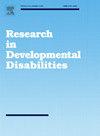儿童诊断时自闭症谱系障碍的临床异质性分析:来自ELENA队列的聚类分析
IF 2.9
2区 医学
Q1 EDUCATION, SPECIAL
引用次数: 0
摘要
自闭症谱系障碍(ASD)包括一组异质性的神经发育疾病,其特征是社会沟通和重复行为的缺陷。ASD患病率的上升凸显了对有效诊断和干预策略的迫切需要。然而,ASD人群中显著的临床、认知和病因异质性给这些努力带来了巨大的挑战。本研究旨在通过结合DSM-5标准以及适应功能和行为问题的测量,在ELENA队列中识别诊断时不同的ASD亚型。材料与方法对458例ASD儿童和青少年的资料进行分层聚类分析。变量包括自闭症症状、智商、适应行为和行为问题。根据这些参数确定聚类,并使用卡方检验和学生t检验进行事后分析,以评估四个聚类之间性别和年龄的统计学显著差异。结果分析结果显示:(1)高自闭症症状严重程度伴最低行为问题;(2)高自闭症症状严重程度伴高行为问题;(3)低自闭症症状严重程度伴最高行为问题;(4)低自闭症症状严重程度伴低行为问题。这些集群在适应性功能和行为问题上表现出显著的可变性,这表明仅凭DSM-5标准并不能完全反映ASD的复杂性。研究结果强调了将适应功能和行为问题纳入ASD评估和干预措施的重要性。未来的研究应致力于在更大、更多样化的人群中验证这些集群,并探索遗传和神经影像学数据的整合,以进一步完善ASD亚型的表征。此外,需要纵向研究来评估这些亚型随时间的稳定性和临床相关性。试验注册号:bernct02625116。本文章由计算机程序翻译,如有差异,请以英文原文为准。
Profiling clinical heterogeneity in Autism Spectrum Disorder at time of children’s diagnosis: A cluster analysis from the ELENA cohort
Background
Autism Spectrum Disorder (ASD) encompass a heterogeneous group of neurodevelopmental conditions characterized by deficits in social communication and repetitive behaviors. The rising prevalence of ASD highlights the urgent need for effective diagnostic and intervention strategies. However, the significant clinical, cognitive and etiological heterogeneity within ASD populations poses substantial challenges to these efforts.
Aims
This study aimed to identify distinct ASD subtypes at time of diagnosis within the ELENA cohort by incorporating not only DSM-5 criteria but also measures of adaptive functioning and behavioral problems.
Material and methods
Data from 458 children and adolescents with ASD were analyzed using hierarchical agglomerative clustering. Variables included autistic symptoms, intellectual quotient, adaptive behavior and behavioral problems. Clusters were identified based on these parameters, and post-hoc analyses were conducted to assess statistically significant differences in sex and age among the four clusters using Chi-square test and Student's t-tests.
Results
Four distinct clusters were identified from the analysis: (1) High Autistic Symptom Severity with Lowest Behavioral Problems, (2) High Autistic Symptom Severity with High Behavioral Problems, (3) Low Autistic Symptom Severity with Highest Behavioral Problems and (4) Low Autistic Symptom Severity with low behavioral problems, while significant age differences were observed across clusters, no significant sex differences were found.
Discussion
These clusters exhibited significant variability in adaptive functioning and behavioral problems, suggesting that DSM-5 criteria alone do not fully capture the complexity of ASD. The findings underscore the importance of incorporating measures of adaptive functioning and behavioral problems into ASD assessments and interventions. Future research should aim to validate these clusters in larger and more diverse populations and explore the integration of genetic and neuroimaging data to further refine the characterization of ASD subtypes. Additionally, longitudinal studies are needed to assess the stability and clinical relevance of these subtypes over time.
Trial registration number
NCT02625116.
求助全文
通过发布文献求助,成功后即可免费获取论文全文。
去求助
来源期刊

Research in Developmental Disabilities
Multiple-
CiteScore
5.50
自引率
6.50%
发文量
178
期刊介绍:
Research In Developmental Disabilities is aimed at publishing original research of an interdisciplinary nature that has a direct bearing on the remediation of problems associated with developmental disabilities. Manuscripts will be solicited throughout the world. Articles will be primarily empirical studies, although an occasional position paper or review will be accepted. The aim of the journal will be to publish articles on all aspects of research with the developmentally disabled, with any methodologically sound approach being acceptable.
 求助内容:
求助内容: 应助结果提醒方式:
应助结果提醒方式:


